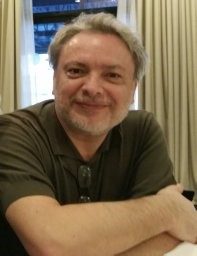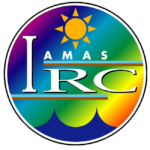
A tribute to our colleague and friend Dr. Michael Mishchenko (1959-2020)
On July 21, 2020, we lost a good colleague and a dear friend, Dr. Michael Mishchenko who was a scientist at NASA Goddard Institute for Space Studies.
In 1983, Michael Mishchenko graduated from one of the most prestigious universities in the Soviet Union, Moscow Institute of Physics and Technology. After his graduation, he worked in the Ukrainian National Academy of Sciences, where he received his PhD in 1987. Michael joined NASA Goddard Institute for Space Studies in 1992, first as a contractor and since 1997 as a senior scientist.
Michael’s seminal research on the theory and applications of electromagnetic scattering, radiative transfer, and remote sensing has largely defined the progress of these disciplines over the past three decades. His pioneering studies have resulted in more than 310 peer-reviewed journal papers (note that Michael first-authored 158 of them) and four state-of-the-art first-authored monographs. As of 3 September 2020, the number of Google Scholar citations of Michael’s publications exceeds 31900, while his h-index is 85 (https://scholar.google.com/citations?user=Q5-7dVYAAAAJ&hl=en).
In the 1990s, Michael pioneered systematic physics-based sensitivity analyses of the entire hierarchy of tropospheric aerosol retrieval algorithms based on radiance as well as polarization measurements from space. His multi-decadal global satellite climatology of aerosol amount and size derived from multi-channel observations with NOAA’s Advanced Very High Resolution Radiometers (AVHRR) revealed the complexity of short- and long-term aerosol trends as well as the immense complexity of retrieving the requisite aerosol properties from space. This work made the advantages of advanced polarimetry clear for resolving the longstanding aerosol climate-forcing problem, and provided key justification to formulate and materialize the NASA Glory Space Mission for global aerosol measurement, which Michael led as Project Scientist. A misfortune at launch has postponed realization of this much-needed aerosol data. Fortunately, two aircraft versions of the Glory’s Aerosol Polarimetry Sensor have been deployed in numerous field campaigns and have been providing mounting evidence of the great power of polarimetric aerosol and cloud remote sensing. Michael remained a staunch adherent of polarimetric remote sensing of the atmosphere and made significant efforts to promote polarimetry in the community. For example, he made key contributions to initiating a series of workshops called Advancement of POLarimetric Observations: Instruments, calibration, and improved aerosol and cloud retrievals (APOLO), to integrate various research communities in promoting, developing and implementing remote sensing polarimetry.
From 1998-2002, Michael served as Project Manager for the NASA/GEWEX Global Aerosol Climatology Project. This program coordinated efforts of 33 research groups worldwide with the aim of improving the knowledge of aerosol properties related to aerosol direct and indirect effects on climate. Among the outcomes of this program were three Science Team meetings and a comprehensive special issue of the Journal of the Atmospheric Sciences.
Another cutting-edge research contribution of Michael is his breakthrough advancement of the T-matrix method. Specifically, he proved that the T-matrix of a particle is independent of its orientation and developed an effective and accurate approach to compute analytically the single-scattering properties of randomly oriented particles – a problem of great practical importance. Furthermore, Michael developed a software package based on the T-matrix method to compute the complete set of scattering and polarization properties of morphologically complex particles. This package has been publicly available online since 1997 and has been extensively used by researchers working in atmospheric radiative transfer, remote sensing, and oceanic optics – as well as in biomedical optics, photonics, astrophysics, electrical engineering, and many other applied-science fields as demonstrated by its use in more than 1430 peer-reviewed publications worldwide. This work was summarized in a Cambridge University Press monograph entitled Scattering, Absorption, and Emission of Light by Small Particles and is among the most significant bodies of research on light scattering by nonspherical particles accomplished over the past several decades.
Using his ingenious and powerful T-matrix methodologies, Michael performed pioneering studies of the effects of morphological particle complexities on the resultant radiative, polarization, and depolarization properties of mineral aerosols, fractal-soot and soot-containing aerosols, soot-contaminated cloud droplets, contrail particles, and polar stratospheric clouds. In 1997 he developed the optical model of mineral aerosols as represented by a size/shape mixture of randomly oriented spheroids, which has become a widely accepted benchmark. Michael was first to quantify the persistent errors in dust-aerosol retrievals with passive satellite instruments resulting from the neglect of particle nonsphericity and parameterized the effects of particle shape in several aerosol remote-sensing algorithms used in routine analyses of ground-based, airborne, and satellite data. In addition, he showed that random-fractal models could eliminate factor-of-two radiative forcing errors caused by the neglect of nonsphericity in remote sensing of black-carbon aerosols. It is not an overstatement to say that practically all algorithms currently used for interpreting spaceborne, airborne and ground-based observations have greatly benefited from Michael’s ideas in accounting for nonspherical shapes of aerosol and cloud particles.
In 1995, Michael deduced a rigorous relationship between the linear and circular depolarization ratios for randomly oriented nonspherical aerosol and cloud particles. This result is widely considered to be among the most profound theoretical contributions to lidar remote sensing over the past three decades and has been central to the conceptual framework of dozens of patents.
On the most fundamental level, Michael finally solved the longstanding problem of establishing the actual physical origin of radiative transfer theory – the foundation of remote-sensing research. Following pioneers such as Viktor Twersky, Akira Ishimaru, and Leung Tsang, he revealed the inherently tensorial nature of electromagnetic energy transport in aerosol and cloud media, established the physical-optics content of radiative transfer theory by deriving it directly from the Maxwell equations, and clarified the physical nature of measurements with well-collimated radiometers. Furthermore, he provided the first quantitative validation of the radiative transfer equation by testing its predictions against the results of controlled laboratory measurements and direct computer solutions of the Maxwell equations. In essence, Michael’s research has served to rescue the phenomenological radiometry conceived by Bouguer and Lambert long before the development of modern theories of light-matter interactions by placing under it a modern physics-based foundation. Furthermore, the totality of Michael’s contributions signifies a fundamental shift from the thoroughly outdated phenomenological paradigm that we owe to Lommel, Chwolson, and Schuster. This profound research was summarized in Michael’s monograph Multiple Scattering of Light by Particles, also published by Cambridge University Press.
In the recent years before his passing, Michael focused on a first-principles analysis of effective-medium approximations routinely used in remote-sensing research to model optical properties of heterogeneous aerosol and cloud particles. Besides clarifying the microphysical roots of these heuristic approximations, Michael was the first to prove definitively the existence of the effective-medium scattering regime and establish its range of applicability using the most recent version of the superposition T-matrix method.
Separately, we would like to outline Michael’s remarkable contributions to astronomy. His T-matrix ideas and codes have been also widely used for remote sensing of various types of cosmic dust (interstellar, circumstellar, interplanetary, cometary, and planetary aerosols). Especially successful was his T-matrix approach and associated codes, developed together with Daniel Mackowski, for electromagnetic scattering by clusters (aggregates) of spheres. Since the majority of cosmic dust particles are aggregates, this is currently one of the main computer modeling techniques for remote sensing of cosmic dust. Michael’s series of techniques for the computation of polarized bidirectional reflectance of flat particulate layers and rough surfaces is a great contribution to the interpretations of ground-based and in-situ data for planetary atmospheres and surfaces, natural satellite surfaces, and surfaces of solar-system small bodies (asteroids and cometary nuclei). The astronomical community especially appreciates that he developed and put online numerous FORTRAN codes, which are widely used. Coherent backscattering had been recognized as an important contributor to light scattering by astronomical objects. However, for some time, its contribution was considered semi-empirically, which very much limited its remote-sensing capability. Michael revealed the physical nature of coherent backscattering phenomena (opposition spike and negative polarization) as the effects associated with the weak localization of photons, and developed qualitative and quantitative approaches to account for coherent backscattering in remote sensing of cosmic bodies. His findings are recognized as benchmark results for interpretation of the opposition spike and negative polarization for planetary rings and surfaces of small bodies. The results of his astronomical studies were summarized in a monograph Polarimetric Remote Sensing of Solar System Objects published in 2010. This book received the State Prize of Ukraine in the field of science and technology for 2011.
In addition to his highest-rated scientific accomplishments, Michael made sustained contributions to the well-being of the international applied optics, radiative transfer, and remote sensing communities. He served as Topical Editor of Applied Optics for 6 years and, since 2006, was Editor-in-Chief of the Journal of Quantitative Spectroscopy and Radiative Transfer. Furthermore, Michael organized 10 major remote-sensing conferences, including six Electromagnetic and Light Scattering Conferences and two NATO Advanced Study Institutes.
Michael’s scientific accomplishments have widely been recognized as benchmarks by the research community. He was elected a Fellow of the American Geophysical Union, Optical Society of America, American Meteorological Society, and The Institute of Physics (UK). Among his numerous awards and honors are two NASA Exceptional Scientific Achievement Medals, the AMS Henry G. Houghton Award, and the prestigious Hendrik C. van de Hulst Award presented by Elsevier in the field of electromagnetic scattering and remote sensing. Most recently, he received the Fran?ois Arago Award in Polarimetric Remote Sensing (2019).
Michael’s groundbreaking scientific accomplishments and voluminous service to the international remote-sensing & radiative transfer community will continuously inspire us and future generations of researchers, particularly in the disciplines of electromagnetic scattering, radiative transfer, and remote sensing. As a tribute to Michael’s extraordinary scientific career, we would like to borrow the words written by Nobel Laureate S. Chandrasekhar in a dedication to his role model, a mathematical genius, Mr. Srinivasa Ramanujan: “It is hopeless to try to emulate him. But he was there even as the Everest is there.“
By Ping Yang, Brian Cairns, Alexander Marshak, Oleg Dubovik, Ludmilla Kolokolova, Andrew Lacis, and Larry Travis
